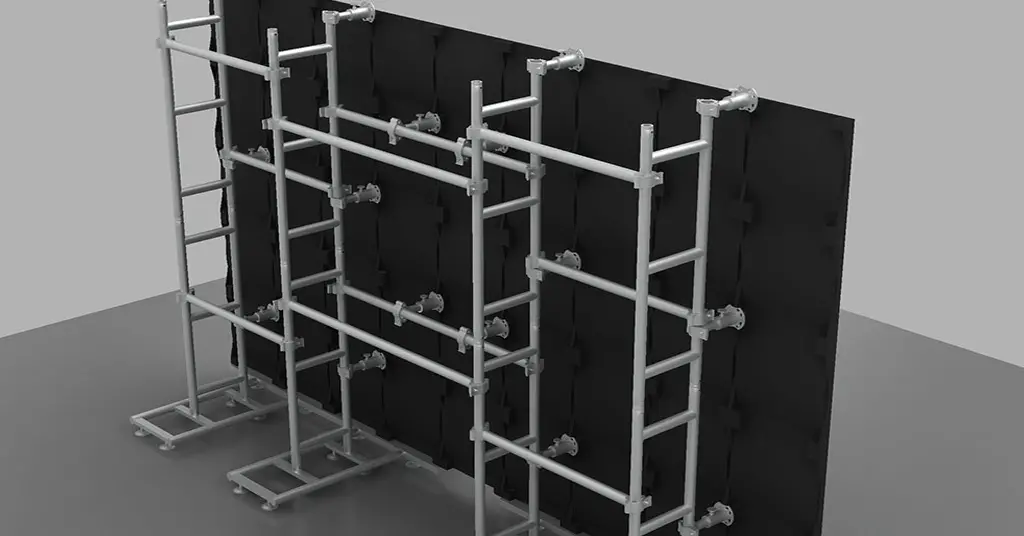What are the key considerations for designing the supporting structure for a large stadium LED screen?
LED screens are being adopted by more and more stadiums, which can not only improve the audience experience, but also greatly increase the income of event operators.
The design and construction of the large LED screen in the stadium is a job that tests the strength of the construction team. In particular, the supporting structure of the stadium LED screen is the core of the work in the entire stadium audio-visual system integration project.
In this article, we discuss the key factors to consider when designing the support structure for a large LED screen in a stadium. Galaxyav is an enterprise with more than 20 years of experience in the design and installation of audio-visual system integration projects. Our professional advice in this field is worthy of your trust.
Table of Contents

Overall LED screen weight
The overall weight of the LED screen is the primary consideration when designing the support structure. The total weight of all LED display panels will reach several tons or even dozens of tons.
Such a huge weight is absolutely impossible to achieve without a strong and stable support system. If the support structure of the LED screen is to bear such a huge weight, it is necessary to fully consider the building structure including the foundation, beams, load-bearing columns, etc. at the beginning of the project design.
wind load
Stadium LED screens sometimes face large wind loads (except for some indoor stadiums, such as NBA indoor stadiums). Outdoor gymnasiums are usually designed by a semi-enclosed elliptical structure, which will cause serious indoor wind effects when facing strong winds.
The ring-shaped led screen video wall of the stadium is less disturbed by wind force because the back is fixed on the outer wall. The square LED screen supported by a single steel frame may cause the bolts to loosen due to the direct wind, and the steel frame structure shakes, which will lead to the collapse of the entire LED screen.
The frequency and magnitude of the earthquake
The movement of the earth’s plates causes new earthquakes to occur every day, but most earthquakes have little impact because the magnitude of the earthquake is small. Take Japan as an example. It is located on an active volcanic eruption belt, and there are many strong earthquakes every year. Therefore, Japanese stadiums often fully consider earthquake factors when designing and constructing LED screen support frames.
Different from other countries, Japan will add a lot of shock absorption and energy absorption equipment when building large-scale support frame structures to ensure that large-scale projects of this type will not tilt or collapse in moderate earthquakes.
Ease of maintenance
Regular maintenance and overhaul of the LED screen is a prerequisite to ensure that it can work and maintain a normal service life. For this reason, the stadium audio visual solution service provider needs to reserve enough maintenance space when designing the support frame, so that professional maintenance personnel can enter and exit to perform maintenance tasks.
If it is a front LED screen panel, you don’t need to think too much about this problem, because most of the maintenance work is done on the front of the LED screen.
However, this type of LED display panel is relatively expensive, and is rarely used in large-scale stadiums.
Compatibility of screen specifications
The supporting structure needs to be compatible with the specifications of the LED screen. Before designing and building the support structure, the LED screen manufacturer will provide product installation instructions and precautions.
These installation instructions should include weight, dimensions, minimum support spacing and type of fasteners for a single LED screen panel. Architects and construction units must refer to these product parameters when designing the support structure, otherwise there will be serious safety hazards.
The design and construction of the stadium’s large LED screen is a professional project, especially the part of the supporting structure will test the level and strength of the stadium audio visual solution provider.
When designing the supporting structure, it is necessary to fully consider the five aspects of screen weight, wind load, earthquake load, maintenance convenience, and compatibility of screen specifications.
If you have stadium audio visual solution needs or some professional questions about stadium led screen, please contact us. We will give you free project design proposal and professional question answering.
Others also read the following article
Want to know more about the Audio Visual Solutions?
